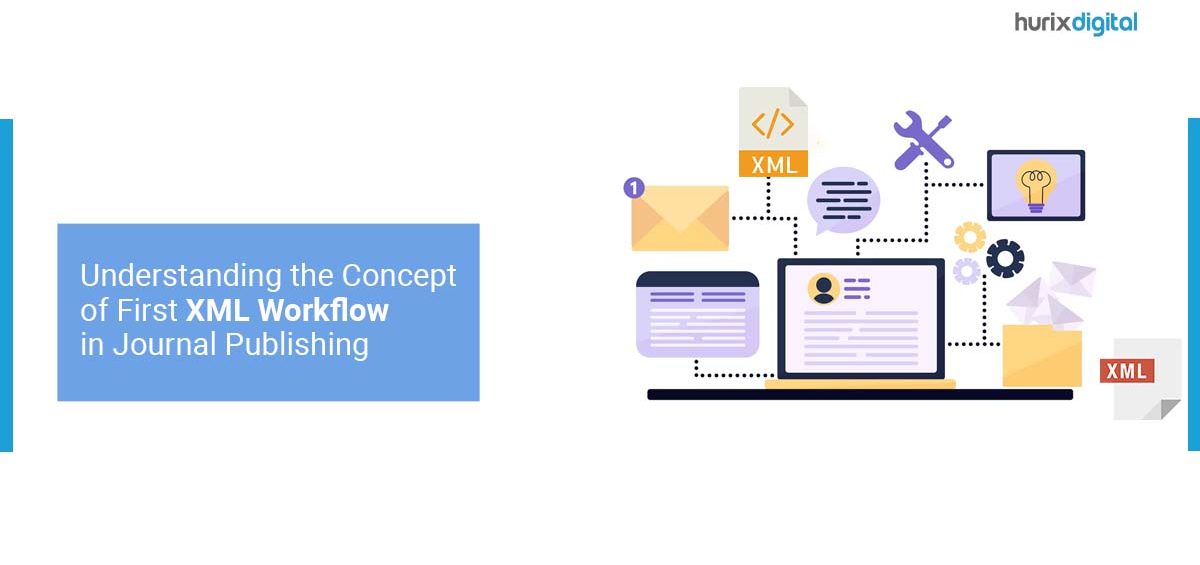XML (Extensible Markup Language) workflow refers to a process or sequence of steps involving the creation, manipulation, and transformation of XML documents. XML is a popular markup language used for structuring and storing data in a human-readable and machine-readable format.
Table of Contents:
- General Overview of a Typical XML Workflow
- Traditional Way of Publishing
- Birth of First XML Workflow
- Why Following an XML Workflow in Journal Typesetting is Beneficial?
- First XML Workflow
Here is a general overview of a typical XML workflow:
a. XML Document Creation: The workflow begins with the creation of an XML document using an XML editor or authoring tool. The document is structured using XML tags, which define the elements and their relationships within the document.
b. XML Document Validation: Once the XML document is created, it may need to be validated against a specific XML schema or Document Type Definition (DTD). This step ensures that the document adheres to the defined structure, data types, and constraints.
c. XML Document Editing: XML documents often require modifications or updates. The workflow may involve editing the XML document to add, remove, or modify elements, attributes, or values. This can be done manually or through automated processes.
d. XML Document Transformation: XML documents can be transformed from one format to another using technologies like XSLT (Extensible Stylesheet Language Transformations). Transformation allows you to extract, restructure, or present data from the XML document in a different format, such as HTML, PDF, or another XML schema.
e. XML Document Parsing and Processing: In many workflows, XML documents need to be parsed and processed by software applications. This involves extracting data from the XML document, performing calculations or operations, and generating outputs or performing specific actions based on the data contained within the XML.
f. XML Document Integration: XML is commonly used for data interchange between different systems or applications. Integration involves sending or receiving XML documents between different software components or systems, enabling seamless communication and data exchange.
g. XML Document Storage and Retrieval: XML documents may be stored in databases, file systems, or document management systems for future retrieval and reference. Appropriate storage and retrieval mechanisms are employed to ensure efficient management of XML data.
It’s important to note that XML workflows can vary greatly depending on the specific requirements of a project or application. Different tools, technologies, and processes may be employed at various stages to facilitate the desired XML-related tasks.
Journal publishing has a long and rich history that dates back several centuries. A brief overview of the key milestones in the history of journal publishing.
Know more about Why Do Publishers Need An XML Workflow
1. Early journals: The first academic journal, the Journal des Sçavans, was established in France in 1665. This was followed by the Philosophical Transactions of the Royal Society in England in 1666.
2. 18th and 19th centuries: The 18th and 19th centuries saw significant growth in the number of academic journals, as new fields of study emerged and scientific discoveries accelerated. Many of these journals were published by learned societies, which were established to promote the advancement of knowledge in specific fields.
3. Rise of commercial publishing: In the late 19th and early 20th centuries, commercial publishers began to play an increasingly important role in journal publishing, as they saw the potential for profit in the growing academic market.
4. Digital publishing: The advent of the internet in the late 20th century revolutionized journal publishing, as it made it possible to disseminate articles electronically, reaching a much larger audience than was previously possible. Electronic publishing also made it easier to search and access articles and facilitated the development of new publishing models, such as open access.
5. Open access: The open access movement, which began in the early 2000s, aims to make research freely available to everyone, regardless of their ability to pay for access. Open-access publishing has grown rapidly in recent years, as more and more funding agencies and institutions require researchers to make their work freely available.
6. Future of journal publishing: The future of journal publishing is likely to be shaped by ongoing technological advances, changing funding models, and evolving reader expectations. Some of the key trends that are likely to shape the future of journal publishing include open science, machine learning, and artificial intelligence, and the increasing importance of data and analytics in academic research.
Traditional Way of Publishing
Before the first XML workflow was introduced, the traditional way of journal publishing involved a series of manual and time-consuming steps that required a significant amount of effort from editors, typesetters, and printers. Here are the main steps involved in traditional journal publishing:
1. Manuscript Submission: Authors would submit their manuscripts to the journal editor by mail or fax.
2. Manuscript Review: The editor would then review the manuscript and send it out for peer review.
3. Peer Review: Peer reviewers would read the manuscript, provide feedback, and recommend whether it should be accepted, rejected, or revised.
4. Manuscript Revision: If the manuscript was accepted pending revisions, the author would make the necessary changes and resubmit the manuscript.
5. Copyediting: Once the manuscript was accepted, it would be sent to a copy editor, who would check for grammar, spelling, and consistency.
6. Typesetting: The copyedited manuscript would then be sent to a typesetter, who would format the text, add images and figures, and create the final layout of the article.
7. Proofreading: A proofreader would then review the typeset article for errors before it was sent to the printer.
8. Printing: The final typeset manuscript would be sent to the printer, who would print the article and send it back to the publisher.
9. Distribution: Finally, the publisher would distribute the printed journal to subscribers and libraries.
Birth of First XML Workflow
The traditional process was time-consuming and often led to delays in publication. With the introduction of XML workflows, many of these steps have been automated, leading to faster publication times and more efficient production processes.
Demand for a quick and short turn-around of the article’s life cycle made Publishers implement the First XML workflow which will enable quick delivery of XML packages to Online hosting platforms.
There are several reasons why following an XML workflow in journal typesetting is beneficial:
1. Standardization: By using XML as the standard format for journal articles, publishers can ensure that all articles are structured consistently, making it easier to manage and automate the publishing process.
2. Flexibility: XML allows for the separation of content and presentation, which means that the same content can be presented in multiple formats, such as HTML, PDF, and ePub. This flexibility is particularly important in today’s digital publishing landscape, where readers have access to content on a wide variety of devices and platforms.
3. Efficiency: Because XML is a machine-readable format, it can be easily manipulated and transformed using automated tools, such as XSLT stylesheets. This makes it possible to automate many aspects of the publishing process, resulting in faster turnaround times and lower costs.
4. Accessibility: By embedding metadata and using semantic markup, XML makes it easier for search engines and other tools to discover, index, and categorize journal articles, increasing their visibility and accessibility to readers.
Overall, following an XML workflow in journal typesetting can help publishers streamline their operations, reduce costs, and improve the accessibility and discoverability of their content.
Also read, A Beginner’s Guide to XML Content Development
First XML Workflow
Typical first XML workflow in journal typesetting involves styling and conversion of the manuscript to XML.
1. The author submits their manuscript in a standard format, such as LaTeX, Microsoft Word, or PDF.
2. The publisher applies the necessary styles to each element and converts the manuscript into an XML format using specialized software or a third-party service. This step involves mapping the document’s structure to a predefined XML schema, which defines the elements and attributes that can be used in the document.
3. The publisher then applies a series of transformations to the XML document to convert it into a format suitable for typesetting. This may involve applying stylesheets to define the visual appearance of the document, converting mathematical notation into MathML, and embedding metadata such as author information and keywords.
4. The typeset document is then generated by applying further transformations to the XML document. This may involve breaking the document into pages, applying hyphenation and justification, and inserting graphics and other media.
5. The final output is typically a PDF file, which can be printed or distributed electronically. The PDF file can be generated directly from the typeset document, or by converting the typeset document back into a PDF format.
Throughout the workflow, the XML document serves as an intermediary format that can be easily manipulated and transformed without losing the underlying structure and meaning of the document. This makes it possible to automate many aspects of the typesetting process, resulting in faster turnaround times and lower costs for publishers.
Reach us here to know more: marketing@hurix.com








